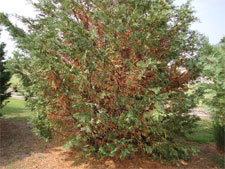Question and Answer – July 2010
Dear e-gardens subscriber: I’d like to help with your plant question, but I will ask that you always include a photo of the problem/plant, and that you identify your city so that I can be more specific with my answer. I always choose questions that are of the widest reader interest, so plant ID questions are rarely included. Your local nurseryman can better help you with those. That said, here are this month’s questions and my best attempts at their answers. (Click here to send me your photo and question.) As much as I’d like to reply to each question individually, there just isn’t enough time. I appreciate your understanding.
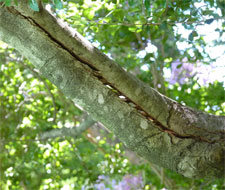
Question: Last winter, after the heavy snowstorm, our yaupon holly was cracked. This branch is 5 inches in diameter. Can it be bolted back together? We’d really hate to lose it. C.C., Dallas.
Answer: If it hasn’t started to decay or dry out unmercifully, then yes, you could try bolting it back together. If you’re going to try to clamp it, be sure to pad the jaws of the clamp, so they won’t compress or rupture the bark. Drill completely through the branch at right angles to the crack, and put a bolt, washer and nut every 2 to 3 inches. Do not leave anything wrapped around the branch. It would probably be best not to apply pruning sealant. If all this fails and the branch dies anyway, reshape your plant. It will quickly regrow, and you can probably salvage the plant within a couple of years.
Question: We had to remove a 15-year-old live oak last year, and I had the stump ground out. Sucker sprouts started coming up immediately. This spring, I dug down and drilled into the remains of the stump and poured broadleafed weedkiller (with 2,4-D) into the holes I made. The sprouts continue to shoot up. Do I just need to be more patient? S.R., Arlington.
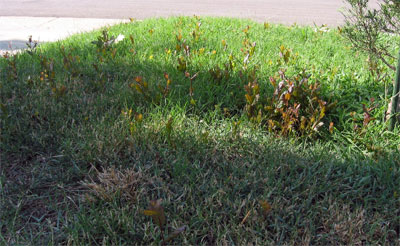
Answer: The weedkiller probably would have been much more effective had you done the drilling and filling a year ago, as soon as the top of the tree had been removed. By now, the suckers have developed their own root systems, so it’s not as likely that the herbicide will be carried out from that original stump. Spray the sprouts with the same material, but mix it at the recommended spraying strength. Keep mowing them the balance of this year. They’ll give up before much longer.
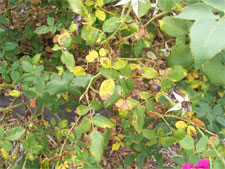
Question: Some of the leaves of my ‘Knock Out’ roses are yellowing. What can I do to stop it? L.F., Denton.
Answer: This is black spot on roses. It’s a recurring problem on most varieties. The original single red ‘Knock Out’ is highly resistant to it and usually bounces back quite well if it ever shows up. For that and other reasons, it was deemed to be EarthKind® by Texas A&M several years ago. The other types of ‘Knock Out’ roses have varying degrees of resistance to the disease. Black spot won’t be much of a problem in the hot, dry summer weather. If it shows up again this fall, start a spray program immediately with a labeled rose fungicide.
Question: What can I do to help my Leyland cypress? I have several, all planted five years ago. Is this a result of our cold, wet winter and early spring, or some type of insect? G.H., Pottsboro.
Answer: Leyland cypress trees have a couple of serious disease problems, and I think that’s what’s wrong with your tree. Please read through this bulletin from North Carolina State University for details and help: (It doesn’t look like there will be a lot you can do, however.) Also, we’ve had a terrible year for spider mites attacking Leyland and Italian cypresses, junipers, arborvitae and other cone-bearing species. In those cases, the plants turned brown from the inside out, almost like a tan glow mushrooming up within the canopy of each plant. You can see the mites by thumping a suspect leaf over a sheet of white paper. The tiny mites will start to move around after 10 to 20 seconds. Apply malathion or acephate to control them if you see them. I don’t think that’s the cause of your plants’ problems, however.
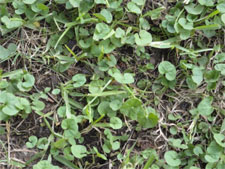
Question: My St. Augustine is being overrun with dollarweed (see photo). I can’t use weed-and-feed fertilizers because of my trees, and the St. Augustine isn’t able to overtake it. What can I do? C.N., Fort Worth.
Answer: First, this is dichondra, not dollarweed. That really doesn’t matter much in terms of controlling it, but you might want to know it sometime in the future. Dichondra is fairly easily controlled with application of a broadleafed weedkiller containing 2,4-d. (I am not an advocate of weed-and-feed products.) Using one of the broadleafed weedkiller products will allow you to spot-treat the weeds without fear of damaging your trees. Use a trigger-sprayer bottle or a pump sprayer to apply it, and use it only on the areas that specifically have the weeds. Do not use a hose-end sprayer. The droplets from these sprayers are too large, and won’t stay on these funnel-shaped little leaves. It will take three or four weeks to get rid of it. All of your spraying should be done early in the morning, before the sun hits the grass and before temperatures start to climb.
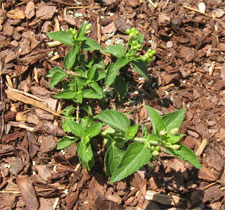
Question: I planted ‘Pink Caprice’ lantanas more than a month ago, and they’re just sitting there. No new blooms and no new growth. What do I need to do? J.J., Rockwall.
Answer: Lantanas bloom as they grow, and it really appears that your little plants need water and, especially, nitrogen. Use a water-soluble plant food that’s high in nitrogen for the quickest pick-up response. Repeat it every week for a month, but apply a slow-release, high-nitrogen granular fertilizer, too, so that it can start taking effect.

Question: What is wrong with my willow tree? It is dying one branch at a time, and insects are attracted to the ooze that is flowing out of its branches and trunk. It is important for shade for our house. What can I do to save it? B.P., Allen.
Answer: Sadly, the life expectancy of willows in home landscapes in most of Texas is less than 10 years, often less than five. They are highly subject to several diseases and at least one insect (cottonwood borers). Cotton root rot fungus and a bacterial disease known as wetwood bother them, and it’s that last problem that most concerns me. By the time the vascular fluids are forced out of willows under pressure, there’s little that can be done to save them. I’d encourage you to involve a certified arborist, but I think they’ll tell you the very same thing. You probably ought to spend the same money investing in a replacement tree instead. Next time you should go for quality and durability, not just for speed of growth. Sorry to have the bad news.
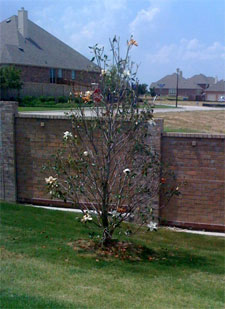
Question: What am I doing wrong with my two Little Gem magnolias? I’ve watered, fertilized and loved them. I can get them to bloom, but not to produce leaves. J., Sachse.
Answer: There is a time in May when all magnolias look a little sparse. That’s when they drop last year’s leaves and replace them with new growth. I think your photo was taken back then. If your trees are still this thin, and if you have given them an all-nitrogen feeding this spring and they still haven’t responded, they may be struggling because they have gotten way too dry, perhaps only one time, and as long as a year or more ago. At some point, you may decide to replace them. That might not be a bad idea if they don’t respond soon.


